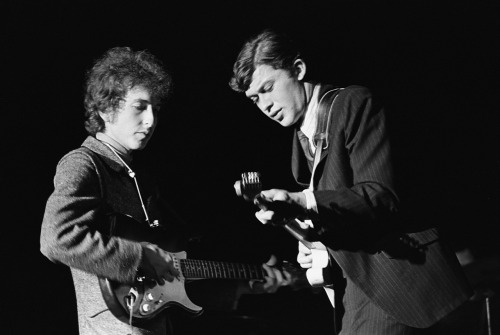
Forty-eight years ago, on February 4, 1966, Bob Dylan and the Hawks kicked off their unprecedented 1966 world tour.
Unprecedented because never before had a popular artist so radically altered their art.
Less than a year earlier, in May of 1965, Dylan had completed a tour of England at the Royal Albert Hall. That tour was documented in “Don’t Look Back,” and during it Dylan remained the folk singer — playing harp and an acoustic guitar.
Dylan was known throughout the world in early 1965 as a folksinger. His first four albums found him playing guitar, harp and piano.
But 17 days after 1965 English tour tour ended, on May 27, 1965, Dylan released Bringing It All Back Home, an album whose first half was a new kind of rock ‘n’ roll, one that mixed caustic poetry with bluesy rock and Dylan’s unique vocals.
Two months later the single “Like a Rolling Stone” was released, and Dylan was a full-fledged rock star.
“Like A Rolling Stone” was a hit, reaching #2 in the U.S. and charting in the Top 10 in a number of other countries including England.
Dylan blew minds when he performed electric rock ‘n’ roll at Newport on July 24, 1965. Dylan and the Hawks played Forest Hills Tennis Stadium in New York on August 28, and then Highway 61 Revisited, Dylan’s first total rock ‘n’ roll album, was released on August 30.
October, November and December found Dylan and the Hawks barnstorming through America.
The 1966 World Tour began in the U.S., but eventually hit Australia and then England, and it was in England, where fans had last seen Dylan with an acoustic guitar, that fans reacted with fury to Dylan going electric.
“They absolutely hated us,” Robbie Robertson said of a tour in which audiences didn’t comprehend some of the greatest rock ‘n’ roll every played.
As Greil Marcus wrote in his book “Invisible Republic – Bob Dylan’s Basement Tapes”: “In America, this music was, in a way, prophetic. At the very least the sound and its reception prefigured an America that, soon enough, for everyone, would be all too familiar: a country split in half over race and war, with battles in the streets, guns fired on college campuses, ghastly riots in cities across the nation, leaders falling to assassins as if on a schedule set by public fantasy, screamers driven from meeting halls with clubs, common citizens driven from their streets with gas and bullets.
“But in the United Kingdom, where after eight months on the road the ensemble had likely reached the limits of their capacities, and reveled at the fact, the hatred for Dylan’s new music and for what he had become was somehow more abstract than in the United States, and more impersonal — uglier.
“It was as if he had betrayed not simply the Freedom Sinfgers, or Woody Guthrie, or the fan who was now shouting, but the Folk immemorial, the mystic chords of memory. The very instinct that history contained identity and one could claim it. In any case the response now made the controversies of the past seasons fade into their own abstraction. In the music Dylan and the Hawks sent off stages in May of 1966, absurdity wars with terror, terror with exultation, exultation with loathing. It was all too much, it couldn’t last and it didn’t.”
Below are live performances from the 1966 World Tour.
“Just Like Tom Thumb’s Blues,” April 13 1966, Sydney:
“I Don’t Believe You (She Acts Like We Have Never Met),” APril 13, 1966:
“Positively 4th Street,” April 13 1966, Sydney:
“Tell Me, Momma,” May 14, 1966, Liverpool:
“Like A Rolling Stone,” May 14, 1966, Liverpool:
“One Too Many Mornings,” May 16, 1966, Sheffield:
“Leopard-Skin Pill-Box Hat,” May 26, 1966, Royal Albert Hall, London:
“Ballad Of A Thin Man,” May 26, 1966, Royal Albert Hall, London:
-– A Days of the Crazy-Wild blog post: sounds, visuals and/or news –-